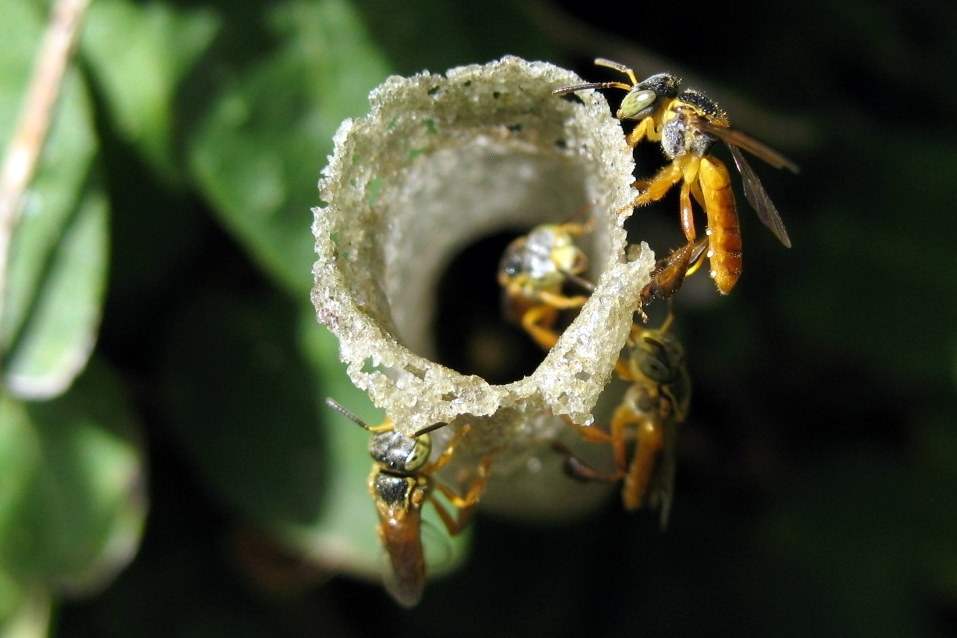

The study by Brazilian researchers showed that the microscopic arachnids rid stingless bee colonies of excessive fungi and serve as food for the larvae of these honey-making insects (photo: Demeter/Wikimedia Commons)
The study by Brazilian researchers showed that the microscopic arachnids rid stingless bee colonies of excessive fungi and serve as food for the larvae of these honey-making insects.
The study by Brazilian researchers showed that the microscopic arachnids rid stingless bee colonies of excessive fungi and serve as food for the larvae of these honey-making insects.

The study by Brazilian researchers showed that the microscopic arachnids rid stingless bee colonies of excessive fungi and serve as food for the larvae of these honey-making insects (photo: Demeter/Wikimedia Commons)
By André Julião | Agência FAPESP – According to an article published in Scientific Reports on a study supported by FAPESP and conducted by researchers at São Paulo State University (UNESP) and the Federal University of São Carlos (UFSCar) in Brazil, mites living in stingless bee colonies favor the survival of up to 69% of bee larvae and 87% of juveniles in the presence of thiamethoxam, a pesticide widely used in Brazil and banned in the European Union (EU), although Brazilian farmers import it from European countries.
In trials without exposure to insecticides, survival rates were as high as 96% when mites were present and as low as 24%-63% without mites. Generally speaking, the study showed that the presence of the mite Proctotydaeus (Neotydeolus) alvearii, which specializes in stingless bee colonies, increased the survival of larvae by a factor of 2.3 without thiamethoxam and 1.9 when the insecticide was present.
The results open a door to the creation of biological solutions to prevent the death of bees, and to future trials to measure the effects of pesticides on stingless bee species. “To begin with, we didn’t even know whether mites were good or bad for bees. There wasn’t any research on the subject. Our study showed mites help bees by eating fungi, which would probably grow too much and suffocate the bees, and also by themselves serving as food for bee larvae,” said Annelise Rosa-Fontana, who conducted the research while she was a postdoctoral fellow at UNESP’s Rio Claro Institute of Biosciences (IBRC) in with a scholarship from FAPESP.
“When mites were present, in trials both with and without the insecticide, we also observed that the bees developed more successfully. Their heads and bodies were significantly larger than in the absence of mites,” said Adna Dorigo, co-first author of the article with Rosa-Fontana. The study was part of Dorigo’s master’s and PhD research at IBRC-UNESP.
The mites probably serve as protein sources for bee larvae when they reach the end of their lives. The researchers observed that mite eggs but no mites were left in the last days of the larval stage, which suggested that the adults were eaten by the larvae.
Before they were detected in colonies of the stingless bee Scaptotrigona postica, the mites in question had been recorded in colonies of other stingless bee species. Described in 1985, the species is totally dependent on this environment, just as other mites specialize in a wide array of other niches (read more at: revistapesquisa.fapesp.br/en/a-zoo-among-the-feathers/).
Risk protocols
Stingless bees are being studied for inclusion in insecticide toxicity trials in the Neotropics, including Brazil. Such trials are required by IBAMA, Brazil’s environment agency, before it approves pesticides. The usual model for these trials has long been the so-called Africanized honeybee, a type of Apis mellifera that originated in accidental crossbreeding of the East African lowland honeybee with European bee species, but Brazil has some 3,000 bee species, about 300 of which are stingless.
Bees are important pollinators of both native plants and crops. They may die or lose the way back to their nests when exposed to pesticides (read more at: agencia.fapesp.br/38915).
Understanding the relationships between crops, pesticides and these insects is the focus of the project “Bee-agriculture interactions: perspectives for sustainable use”, funded by FAPESP and led by Osmar Malaspina, a professor at IBRC-UNESP.
One of the co-principal investigators for the project is Roberta Nocelli, a professor at UFSCar’s Center for Agrarian Sciences (CCA) and a co-author of the article on the study, one of many conducted under the aegis of the project.
“Our laboratory plays a key role in establishing risk assessment protocols for use by policymakers,” said Malaspina, last author of the article. “Bees are essential to ecosystems and agriculture. We must all do everything we can to protect them.”
Another important contribution of the study is to nature-based solutions. Products inspired by the findings could be distributed free of charge to producers of honey from stingless bees (meliponiculturists) or developed by innovative startups.
Education and training is also a key component. Rosa-Fontana is currently a researcher at Complutense University of Madrid (UCM) in Spain. In February, she was awarded a postdoctoral fellowship from Marie Sklodowska-Curie Actions (MSCA), EU’s flagship research funding program for doctoral education and postdoctoral training, and one of the world’s most competitive and prestigious programs of the kind. The fellowship is worth 172,000 euros for investment into research on molecular tools for bee-pesticide risk assessment.
When Dorigo completed her PhD, she was taken on by Eurofins Agroscience Services, a global leader in pesticide toxicology studies. She is currently a researcher and director of studies at UNESP.
The article “Fungivorous mites enhance the survivorship and development of stingless bees even when exposed to pesticides” is at: www.nature.com/articles/s41598-022-25482-x.
Republish
The Agency FAPESP licenses news via Creative Commons (CC-BY-NC-ND) so that they can be republished free of charge and in a simple way by other digital or printed vehicles. Agência FAPESP must be credited as the source of the content being republished and the name of the reporter (if any) must be attributed. Using the HMTL button below allows compliance with these rules, detailed in Digital Republishing Policy FAPESP.





